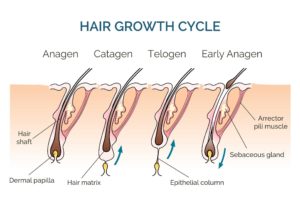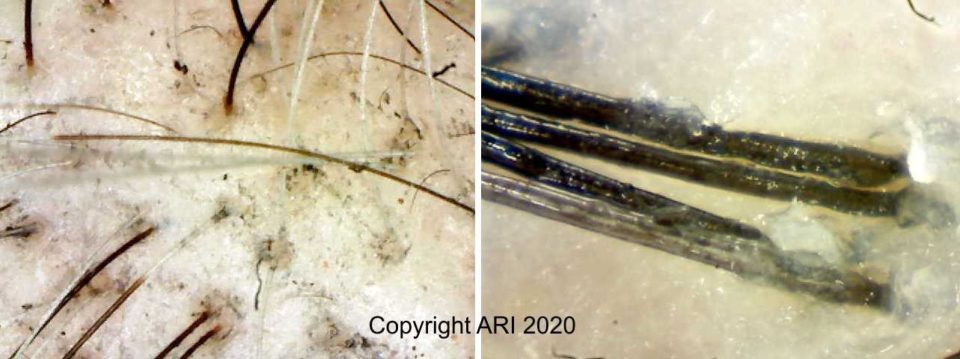Hair Growth and the Hair Growth Cycle
All hair on the body grows in cycles. There are several named stages in the hair growth cycle as illustrated in the diagram below. Knowing how the hair growth cycle works is important to understanding how much hair loss is normal. There are 3 main stages, and several other sub-stages. The Anagen Stage, or growing stage, is the stage where the hair shaft is connected to the papilla (which is the growth centre of the hair shaft), and is actively growing. This stage can last anywhere from 2 to 6 years. During this period hair constantly grows, and if it is never cut, the maximum length of growth of your hair will happen by the end of the anagen stage. At a pre-determined time, the hair will suddenly stop growing and separate from the hair follicle. This stage of separation is called the Catagen Stage and lasts about a week. During this stage the hair is still stuck in the hair follicle, held in place by the cuticle of the hair shaft interlocking with cuticle of the inner root sheath. Once the hair is completely separated from the papilla, the Telogen Stage has started. This is a resting stage for the hair follicle and can last up to three months. During this stage, hair can remain in the follicle, however, it can also be pulled out. It can come out in the shower, or when gently pulled or vigorously brushed. If these hairs have not shed before a new hair starts to grow, usually within about 3 months, they will be pushed out by the new hair. When the hair is pushed out by a new hair, it is called the Exogen Stage and is followed by the Early Anagen or Return to Anagen stage. When you read that people generally lose 50 to 100 hairs per day, this is the hair that is being referred to. A 5th stage called Kenogen represents a hair follicle that has no hair in it, such as when the hair has been pulled out before a new one starts to grow.


During the telogen stage, the dermal papilla, which is the growth control center of the hair shaft, retreats and shrinks deep within the dermis and also rests, reforming about 3 months later when hair root stem cells trigger the follicle to begin production of a new hair. During this time, the supporting blood vessels and nerves also retreat. Eventually the papilla re-forms, blood vessels and nerves re-attach to the follicle and papilla, and hair begins to grow: Early Anagen, or Return to Anagen.
It is important to note that hair that falls out in the shower is telogen hair, meaning it is already in the resting stage, and will eventually be pushed out some time within the next 3 months regardless of how often one shampoos or brushes their hair. So it is important that hair washing be maintained even if you feel that it is causing your hair to fall out. It isn’t, and neglecting your scalp by reducing the frequency of hair washing is actually bad for your hair and scalp, as it can lead to a build up of oils, odour, bacteria, flakes, and other foreign elements.
If hair falls out of a follicle before the new one begins forming, we call this the Kenogen Stage. It is part of the telogen or resting stage, but denotes the period of time when a hair is not present in the follicle. In certain types of hair loss, especially Androgenetic Alopecia or “pattern hair loss”, both the telogen stage and the kenogen stage are often lengthened, leading to an appearance of increased hair loss. The aim of many hair loss treatments is to keep hair in the growing stage longer, and less in the telogen or kenogen stages. We will refer to many of these stages in our discussion of types of hair loss.
